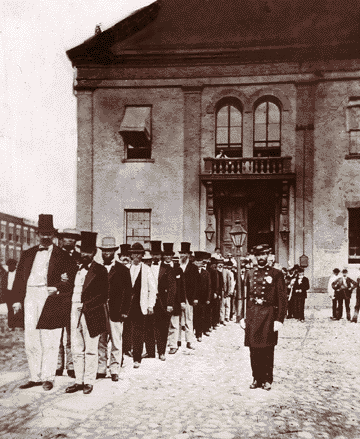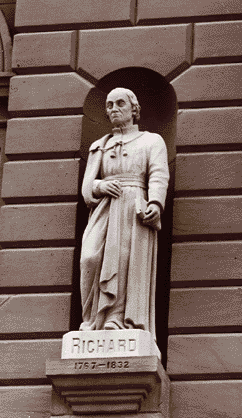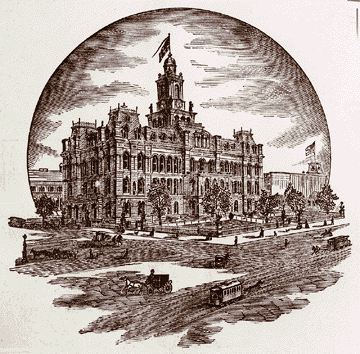Detroit's magnificent old City Hall
By Donald Lochbiler
The poet Henry W. Longfellow called 1876 the "Year of a Hundred Years" in the verses he wrote for America's centennial.
In Detroit the long-awaited celebration began well before midnight Monday, July 3. Rain started to fall at dusk, and by 11 p.m. decorations that had been put up all over town looked in sad shape. But the downpour let up toward 12 o'clock and within a few minutes the downtown streets were alive with merrymakers.

As the City Hall bell struck 12, guns reverberated throughout the city. Church bells struck up a patriotic clangor. The sky was illumined with rockets and Roman candles set off from the top of the City Hall tower.
Rain came down, too, from 10 to noon the morning of the Fourth, the hours of the grand procession up Woodward Avenue--decorated for the occasion from the ferry dock to Grand Circus Park. But nothing could dampen the spirits of the crowd which gathered at the City Hall itself.
Of all the buildings in town that day, Detroiters were proudest of their new City Hall. They would have been as shocked to think it would not last a hundred years as if they had been told that America itself would never complete a second century. But time was to run out for the beloved City Hall before the end of a century run.
It was dedicated on an earlier Fourth of July, in 1871, and there is no mystery about what Detroit's 80,000 inhabitants did that day, of all days. Almost to a man, they spent it marveling at the new edifice.
Young fry explored every turret, tower and balcony. Hardly any citizen was too old to climb the iron stairways to the top of the main tower. Silas Farmer, of course, was among the climbers, and he described the details for use in the history he was planning--it was 13 steps from the sidewalk to the entrance door, 67 to the stairway, 143 to the clock and 213 to the tower.
The view from the top, as Farmer wrote, was magnificent: "The usually clean streets look still cleaner in the distance. The grove of shade trees, the elegant residences, the river and its shipping, the Canadian shore and Belle Isle, all unite to form a panorama not often excelled."

Another reward of the climb was a closeup view of the 14-foot stone maidens on the cornices of the first section of the tower. They represented Justice, Industry, Art and Commerce.
But the top attraction was the tower clock. The largest in America, dedication-day orators boasted. At noon, the pendulum weighing 125 pounds was set in motion. The clock began its appointed task--so the speakers confidently said--of ticking off the centuries.
One of the nation's foremost clockmakers, W. A. Hendrie of Chicago created the clock especially for Detroit. He regarded it as his masterpiece.
Some citizens looked upon Hendrie's bill as something of a masterpiece, too. It was $2,850, and there were scandalized cries against spending that much of the taxpayers' money on a mere timepiece, however huge. But once the City Hall was finished only a few curmudgeons could continue to grumble. Each of the four dials was eight feet, three inches in diameter, and every night illumination was provided so citizerns could tell the time from across the street.

Everyone admired the clock's intricate machinery. A city engineer of a later era described it as "massive and durable as a tractor." Even more massive than the machinery was the bell. It weighed 7,670 pounds and cost $2,782.
Children especially liked the six cast-iron deer which graced the City Hall lawn. The era was one in which inanimate wildlife was considered to add eclat to the urban scene, and stone lions guarded the grounds of numerous fine mansions on Jefferson, Fort and Woodward.
In all, Detroit spent $600,000 on the showplace City Hall. A big outlay admittedly, but the citizens felt it was worth the money.
Three years after the building was completed there was another big Fourth of July. That was when two formidable watchdogs of the peace were added to its adornments. These were cannons captured by Commodore Oliver Hazard Perry from the British at the Battle of Lake Erie, which sealed American victory in the War of 1812.
Niches provided for statues on the east and west sides of the City Hall were left unoccupied until 1884. In that year sculptures of Antoine Cadillac, Fr. Gabriel Richard, Fr. Jacques Marquette and Sieur de LaSalle were added.
Commissioned by a leading citizen, Bela Hubbard, they were carved by the foremost Detroit sculptor of the period, Julius Theodore Melchers. A native of Prussia, Melchers came to Detroit in 1885 after working on the Crystal Palace in London.

The Detroit Business Pioneers instituted a rite of washing the faces of the City Hall clock once a year. The ceremony was on July 24, the anniversary of Detroit's founding. The town's most dignified and venerable business leaders gladly took their turns as steeplejack clock-washers.
If the clock told time for the people, the City Hall itself told their mood--in good times or bad. It was gala with flags and bunting when the 20th century arrived, or when such dignitaries visited the city as Adm. George Dewey, hero of the Spanish-American War, or President Theodore Roosevelt.
It was somber with wreaths when a favorite son like Gov. Hazen S. Pingree died in England and the city counted the days of his long journey home.
Every summer flowers spelled out a big "welcome" sign on the lawn for visitors. In 1944, the lawn gave way to a municipal Victory Garden, planted with vegetables, in a wartime campaign to raise more foodstuffs.
In 1946, after 75 years' accumulated grime had darkened the structure dirty gray, John C. Lodge, dean of the City Council, moved to restore it to its pristine beauty. Sandblasting operations were authorized. Much dust was raised. The building emerged with its creamy yellow sandstone gleaming to the eye. But it was the last blaze of glory.
With the completion of the City-County Building in 1957, old City Hall's days were numbered. Many protested when Mayor Louis C. Miriani announced that razing of the building for an underground garage was being studied. It was urged that it should be preserved as a downtown tourist center. Old-timers like George W. Stark, city historiographer, and Pingree's daughter, Mrs. Wilson W. Mills, president of the Detroit Historical Society led a valiant fight. Legal maneuvers kept the landmark in being past its 90th birthday in 1961.
But that September it fell before the wrecker's ball.
